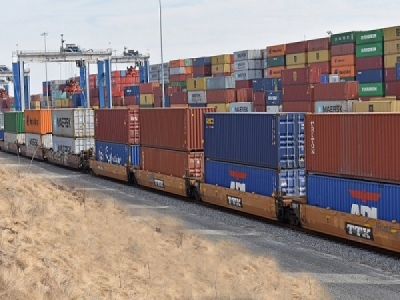
Posted on December 11, 2018
The state of Maryland needs to find an extra $75 million to complete the last piece of the more than six-year old infrastructure expansion plan aimed at attracting Asia cargo — unless CSX Transportation budges and increases its contribution.
A report, compiled by the Maryland Port Administration (MPA) and the Maryland Department of Transportation for the state’s General Assembly, says the railroad in early 2018 reconsidered its decision to pull out of the project to raise the tunnel so that double-stack trains can run on the line connecting to the Port of Baltimore. Both CSX and MPA say talks are continuing on the railroad’s participation.
But CSX has reduced the amount it will contribute by $54 million, from $145 million to $91 million, the report says. The railroad also favors a new engineering technique that would add another $21 million to the project cost, the report says.
If CSX sticks to that plan, it would likely require greater investment from the MPA and the state of Maryland than in the last proposal, in which they committed to providing $145 million. Under that scenario, the Department of Transportation’s (DOT’s) Infrastructure For Rebuilding America (INFRA) program would have contributed $155 million. Because program grants are based on how much non-federal funding is committed to the project, the state and MPA funds would likely have to make up the lost CSX funds to keep the federal portion at $155 million.
The importance of double-stack trains
The ability to bring double-stack trains to and from the marine terminal is considered vital to the port’s growth because it would give shippers better access to the Midwest, making Baltimore more competitive with the ports of New York and New Jersey and Virginia, supporters say. Currently, the only way in is through the Howard Street Tunnel, which is too low in parts to take double-stacked trains.
Baltimore’s tunnel elevation would cap a port upgrade that includes the completion in January 2013 of a dredging project to deepen to 50 feet its channel and berth, which was extended from 3,000 feet to 4,300 feet, enabling the terminal to handle four ships at a time. The port also added four super-post Panamax cranes, to seven existing cranes and acquired 66 acres of new land to stack containers.
Maryland officials have for at least six years analyzed the shortcomings of the tunnel, which is too low by just a few inches in some parts and by 1.5 feet elsewhere. Early estimates of the cost of clearing the blockage put it at $1 billion to $3 billion. The port in 2014 abandoned a plan to move single-stack trains through the tunnel and double-stack them in a yard on the other side, amid community opposition.
The port’s volume of loaded Asian imports into the US rose by 7.4 percent in the first 10 months of 2018, over the same period the year before, to 154,863 TEU, according to PIERS, a sister product of JOC.com. The data show that its market share of Asian imports was 1.3 percent over the period, the same as the two previous years.
CSX decision
CSX pulled out of the project to raise it in November 2017, saying it did not fit in with the new “precision railroading” philosophy brought in by incoming CEO E. Hunter Harrison in 2017, who has since died. Maryland officials have continued to talk to CSX, and the MPA said it continues “to have an open dialogue with CSX as to how we can collaborate to bring this long-supported project to fruition.”
CSX spokesperson Laura Phelps said “several options are under consideration, but no decisions have been made.” She said it would be “premature to publicly discuss the details of alternatives that have yet to be fully reviewed.”
The report, created for two finance committees of the Maryland legislature, was intended to analyze the alternative solutions to the Howard Street Tunnel for enabling double-stack trains to serve the port and the feasibility of each. However, it concluded that none of the four alternatives to the Howard Street Tunnel were viable, and raising the tunnel is the preferred solution.
One proposal would have floated double-stack trains across the harbor on a barge. The report concluded that would be too expensive and would add at least a day to the movement of the cargo. A second proposal, to move cargo in single stacks through the tunnel and create double-stack trains at the outside end, would increase operating costs and require extensive cargo handling to load and unload containers onto trains, the report concluded.
A third proposal, to move containers by barge and load them onto railcars outside the tunnel, would generate unnecessarily high operating costs, the report said. And the fourth proposal, to send double stack trains on Amtrak’s Northeast Corridor, would run into problems fitting into the line’s existing schedule and would require significant construction of bridges and land acquisition, the report said.
A double-stack train is more efficient than a single-stack train and increases the capacity and the economies of scale of the train. Currently, westbound trains can only be single-stack because of the height limitations of the 121-year-old, 1.7-mile long tunnel. To change that, the port planned to elevate some parts of the tunnel and lower others, enabling double-stack trains to pass through.
Maryland applied for $155 million under the DOT’s FASTLANE, or Fostering Advancements in Shipping and Transportation, program in 2016, but was not selected for funding in the face of stiff competition from other projects around the United States.
Source: JOC





